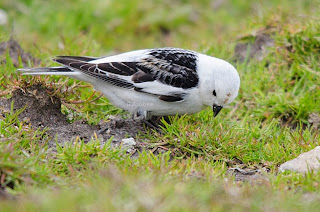From our house in Sheffield it is 70 miles to the nearest coast, so we have to make a special journey to see Snow buntings in winter. Often travelling as far as Salthouse in Norfolk or into Lincolnshire to find these delightful birds. Often very confiding they can can also be encouraged to come closer by laying seed. We have only seen the odd summer plumage bird, the last one again at Salthouse which is also a favourite site with the birds and birders.
Twite
During our time in Shetland this May and June we were lucky enough to come across a few birds. The first 3 very flighty birds down at Scatness in the South Mainland. These appeared on the wall to the south side before quickly disappearing towards the sea. They made a brief appearance before moving more inland, this was on the 26 May.
At Grutness on the 30 May, a female was seen close to the gate leading to the tern colony. But the best views came on the 1 June at Compass Head when three Snow buntings were seen near the concrete slabs. Soon another couple of people arrived , one in a car and we set up using the car as cover. Seed was again laid and within 10 mins a couple of birds could be seen on the top of a building drinking water. They then flew down to the seeded area where a Twite was already feeding, one bunting flew straight off leaving a superb male and a female close by. They edged closer giving great views before being chased by a low flying Gt Black Backed gull.
Compass Head Snow Buntings
We went to Fetlar on the 3 June, hoping to see Phalaropes down at Funzie. No immediate sign of the Phalaropes on arrival but my attention was drawn to a Whimbrel that landed close by. I then noticed several Dunlin feeding in a grazed area and was draw to a white bird that briefly emerged from behind a rock. This was another cracking male Snow Bunting. Then others appeared, another 2 males and 2 females that fed close together. I then crawled on my stomach for 20 yards through sheep poo to get closer. They were totally unconcerned as I lay close by and was able to get some close photos especially of the males.
Fetlar Snow Buntings
We stopped off at Brough Lodge watching Ringed Plover, Dunlin, Turnstone and several terns in the fog when a raptor came in off the sea. As it moved towards the Lodge we identified it as a male Marsh Harrier, an uncommon migrant up in Shetland, it soon moved off as it was mobbed by several gulls and Hoddie crows.
Fetlar Marsh Harrier
While waiting for the return ferry I met up again with Martin Garner (Birding Frontiers), who also lives in Sheffield(didn't know at the time- its a small world), who was eager to see the photos and suggested that on first glance they may possibly be the Siberian race Snow Buntings. I have since sent some photos to him to look at more closely, so I will let you know the outcome.
Fetlar Snow Buntings
It would be very interesting if they are, three races of snow bunting visit Britain. Greenland, Icelandic and Scandinavian, with the Icelandic birds the most common. The Siberian race birds (ssp.vlasowae) have only been reported six times in Western Europe.
Although no Snow buntings have been reported breeding in Shetland, two males and a female were present on Ronas Hill from the 24 May - 12 July, with the males in song and alarm call heard suggesting a breeding attempt- Shetland Bird Club















We have also seen a couple of snowbuntings in the summer (end of june) of 2014. I never realised that this was rather special. I took some foto's, not very special but good enough for identification. If you want i can send them. Kind regards Hans Kemme
ReplyDelete